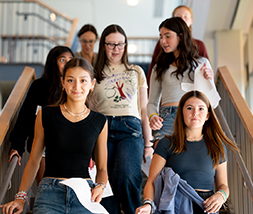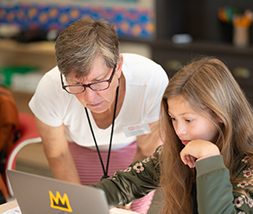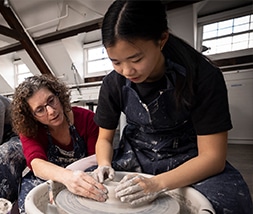The Essential Winsor Science Chair is one of the eight endowed chairs and is given to a member of the science department to acknowledge their exceptional teaching and dedication to students. The Essential Winsor Science Chair was established in 2003 by Lee T. Sprague ’58, Eleanor Lewis Campbell ’46, and the Honorable Levin H. Campbell GP’15, as well as Nancy and Michael Tooke P’98, all of whom wanted to both recognize and support the exceptional work of the Winsor science program.
The Chair has been held by five excellent teachers over the past 19 years. The previous chair was Kim Ramos who held the position until she became the Upper School Head this past year. Prior to Kim Ramos, Denise Labieniec held the chair until she became Dean of Studies, and she currently serves as Institutional Researcher.
Ken Schopf was announced as the new Essential Winsor Science Chair on June 2, at an all-school Assembly where Head of School Sarah Pelmas shared a speech dedicated to Ken Schopf.
Ms. Pelmas’ remarks are abbreviated below.
He came to Winsor first in 2004. I say “first,” because there was also a “second” time to his employment at Winsor, which I will tell you about. In 2004, we had been trying to hire a middle school science teacher, but had not seen strong candidates. Then along came this teacher. He loved fossils and rocks, had studied Paleontology under the legendary Stephen J. Gould at Harvard, and for his sample teaching lesson, he brought fossils with him from his home. The students lit up in his sample class. The department all took to calling him Ross, because he was such a paleontology nerd and the TV show Friends was still on air.
When he arrived, he jumped immediately into teaching and also rethinking and revising Class III, and pretty much every other Lower School science class. He brought the fish tank to the LS room, changed how we thought about teaching the human body, and introduced new technologies into the science classroom. He created a field trip to the Chestnut Hill Mall and other places around Boston to see outcroppings of rocks that have the same makeup as those in East Africa. He brought equal enthusiasm to his advising, and to his support for rock music at Winsor, starting the Wednesday Night Music Club, Winsor’s first student rock band in the Upper School. Even as recently as a couple weeks ago, he apparently accidentally sent out his band notes instead of his lesson plan for coverage!
In 2010, he and his family moved to Baltimore, Maryland, and then to Cleveland, Ohio, to support his wife’s career. In both places, he taught at girls’ schools, clearly committed to helping empower girls and young women in the sciences and in life. When the opportunity came for his family to move back to Boston in 2016, what a gift to us that there was an opening at Winsor! He arrived for his second turn the very same year I did, and he jumped immediately back into the vibrant science experience he had helped to create. He’s taught at every Lower School grade level as well as Class VII and VIII, and his influence on the curriculum can be found in the hands-on projects, inquiry-based pedagogy, and most recently in the incorporation of standards-based grading. When he first taught Class I, for instance, he designed a trebuchet unit called the Spring Fling. More recently, he organized an upper school Paleobiology field trip to Syracuse (one of the places where the good fossils are), and then this year he brought Syracuse to Winsor by setting up fossils—which he had driven down himself from Syracuse in March—right in the courtyard!
His commitment to diversity and equity is the foundation for all his work. Most recently, he redesigned the Class I naturalist curriculum to include a variety of voices and perspectives, including the more complex issues of environmental justice and urban ecology. He redesigned the Class III curriculum to include a case study on the genetics of skin color and the non-scientific basis for the concept of race, as well as a unit on climate change with an emphasis on environmental equity. He was also the mastermind behind the framed posters of female role models in science, technology, and math along the stairwell as well as the floor-to-ceiling replica of Marie Tharp’s 1977 map of the ocean floor.
He drinks out of a cup that says “Science is not a liberal conspiracy,” something that shows how much he values not only a little snark but also access for everyone to scientific concepts and to the scientific process itself. He sees it as a point of equity. He is always acutely aware that there are actual people sitting before him who have the agency to affect the world in significant ways once they leave Winsor.
He doesn’t teach science; he teaches kids, and he teaches them to be scientists. There simply is no higher goal or accomplishment than that.






